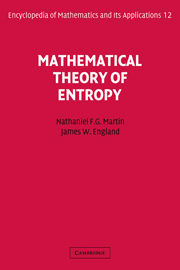Book contents
- Frontmatter
- Contents
- Editor's Statement
- Section Editor's Foreword
- Preface
- Special Symbols
- Mathematical Theory of Entropy
- Chapter 1 Topics from Probability Theory
- Chapter 2 Entropy and Information
- Chapter 3 Information Theory
- Chapter 4 Ergodic Theory
- Chapter 5 Topological Dynamics
- Chapter 6 Statistical Mechanics
- Bibliography
- Index
- About the Author
Preface
Published online by Cambridge University Press: 05 June 2013
- Frontmatter
- Contents
- Editor's Statement
- Section Editor's Foreword
- Preface
- Special Symbols
- Mathematical Theory of Entropy
- Chapter 1 Topics from Probability Theory
- Chapter 2 Entropy and Information
- Chapter 3 Information Theory
- Chapter 4 Ergodic Theory
- Chapter 5 Topological Dynamics
- Chapter 6 Statistical Mechanics
- Bibliography
- Index
- About the Author
Summary
Thirty years ago, Claude Shannon published a paper with the title “A mathematical theory of communication”. In this paper, he defined a quantity, which he called entropy, that measures the uncertainty associated with random phenomena. The effects of this paper on communications in both theory and practice are still being felt, and his entropy function has been applied very successfully to several areas of mathematics. In particular, an extension of it to dynamic situations by A. N. Kolmogorov and Ja. G. Sinai led to a complete solution of a long-unsolved problem in ergodic theory, to a new invariant for differentiable dynamic systems, and to more precision in certain concepts in classical statistical mechanics.
Our intent in this book is to give a rather complete and self-contained development of the entropy function and its extension that is understandable to a reader with a knowledge of abstract measure theory as it is taught in most first-year graduate courses and to indicate how it has been applied to the subjects of information theory, ergodic theory, and topological dynamics. We have made no attempt to give a comprehensive treatment of these subjects; rather we have restricted ourselves to just those parts of the subject which have been influenced by Shannon's entropy and the Kolmogorov-Sinai extension of it. Thus, our purpose is twofold: first, to give a self-contained treatment of all the major properties of entropy and its extension, with rather detailed proofs, and second, to give an exposition of its uses in those areas of mathematics where it has been applied with some success.
- Type
- Chapter
- Information
- Mathematical Theory of Entropy , pp. xvii - xviiiPublisher: Cambridge University PressPrint publication year: 1984

